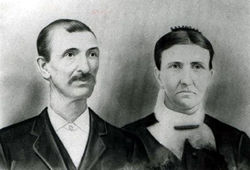john haskew reynolds

|
John
I hadn't thought that my children's children's children
would whimper at splinters, or wear "braces" on their teeth,
as I opened my journal and appended my latest account
to the others, relating my experiences in The War
as calmly as if the lost hand I wrote of was not mine.
Returning to the mountains I lifted up my eyes
to trace the chicken hawk's hanging, gilding, loops,
and gave thanks for my fortune to be returned alive.
I studied life's medicine and doctored many men
and women, and children—seven of my own—
and none complained my left hand was a hook.
from Oak and Mimosa by Alan Reynolds |

|
Born March 25, 1836 on South Turkey Creek, in Bent Creek,
North Carolina, and settled on Big Sandy Mush Creek, "John joined the
Confederate Army and was active in numerous battles in Mississippi and
Alabama. He was a Lieutenant. He lost his right hand in the Battle of
Chickamauga, Georgia on 9-20-1863. After the war he farmed at Sandy Mush,
North Carolina and practiced medicine."
The Genealogy
of Abraham and Mary Leazer Reynolds, Sarah Reynolds Beatty, 1980
On February 13, 1861 when John was 24, he married Sally Ferguson. They had the following children:
i. Joanna (1861-1917)
ii. Alady Pumroy (Allie) (1864-1939)
iii. Eleura Idaly (1867-1956)
iv. Mary Cornelia (1869-1958)
v. Alonzo Carlton (1870-1953)
vi. Thomas Frazier (1872-1927)
vii. Joseph Letcher (1879-1941)
John died at age 82 and was buried June 18, 1918 in Sandy
Mush, North Carolina. |
John Haskew Reynolds
by
Elizabeth Gray Parker
John Haskew Reynolds (1836-1918) was the fourth child of Joseph
Page Reynolds and Cornelia Atkinson. Brought up on his father's farm on North
Turkey Creek in Buncombe County, John lived his life in the rural tradition
of his forebears. His grandfather Abraham Reynolds was as early settler of the
Bent Creek section of Buncombe County, having received seven land grants from
the state of North Carolina totaling 1,525 acres. Joseph Reynolds farmed his
land in the Leicester area. When John Reynolds became of age, he married Sara
Ann Ferguson on February 13, 1861 and settled in Sandy Mush with the intention
of bringing up a family in this rural community. His marriage, however, coincided
with the outbreak of the Civil War, and this made lasting changes in his life.
Soon after the war began, John enlisted as a private in the Confederate
Army and served for three years under Colonel Ray of Asheville. He left behind
his wife and infant daughter who stayed at the home of his father-in-law. During
his service in the army, John rose to the rank of lieutenant. Pages of a diary
he kept at this time give a terse account of his activities.
July 11 - The officers look like they were starved to death
this
morning. I've written two letters today--one to Mrs. Reynolds
and the other to Mrs. H. Lowery and carried them to the office.
July 13 - By request of Lt. Jones I went out foraging and
got
some milk and butter.
Sept. 6 - The orders for marching were received again. We
left
camp at 11:00 a.m. and marched till dark, 12 miles. Stopped for
the night. Almost marched to death. ~
Sept. 19 - This morning the pickets commence firing 8 a.m.
and
the cannonading commenced heavier till 10 a.m. Ordered to march,
forming the line, and then ordered to march again to the field w
where the parties were contending.
On September 20, 1863, John Reynolds went into battle in Georgia.
Sept. 20 - This morning ordered to march at daylight. Marched
2
miles, formed line and rested till 10 o'clock. And ordered for
ward, I got wounded and lost my right hand.
This was the battle of Chickamauga, and during the fighting,
John's right hand was shot and had to be amputated. He continued to make entries
in his diary every day of conditions in the hospital and made little mention
of what must have been a very serious and painful wound. Because of the lack
of antiseptic conditions at the time of his operation, he developed blood poisoning
and almost died. He did recover, however, and he returned to Sandy Mush changed.
He had lost his hand and had gained a lasting interest in medicine.
In the years following the war, John and Sara successfully ran
their farm and raised seven children. They were Joanna (1861-1917), Alady Pumroy
(1864-1939), Eleura Idaly (1867-1956), Mary Cornelia (1869-1958), Alonzo Carlton
(1870-1953), Thomas Frazier (1872-1927), and Joseph Letcher (1879-1941). The
whole family worked to make a living from the land. Besides teaching his children
responsibility and self-discipline and how to farm the land, John passed on
to them a respect for learning. He made sure that all his children attended
Camp Academy in Sandy Mush, and he made it possible for his three sons to continue
their educations past high school. In providing for his children, he decided
to divide his land among his daughters and send his sons to college. One son
became a college president, the second a doctor, and the third a minister.
John Reynolds spent his life learning also. Following the interest
he developed during the war, he ordered medical books which he studied diligently
at his home. Through his studies he became a country doctor and continued practicing
until he retired.
In 1892 Sara Reynolds died. Her husband continued to live in
their attractive two-story frame house in Sandy Mush until all their children
had grown up and gone away. In 1909, after a long, active life, John Reynolds
retired and went to live with his daughter Allie and her husband Nathan Worley
in Canton. He died there on June 17, 1918.
§ § § § §



